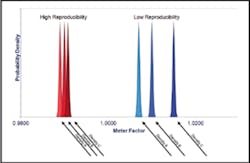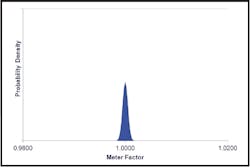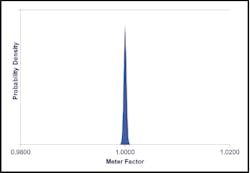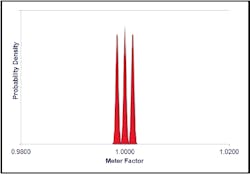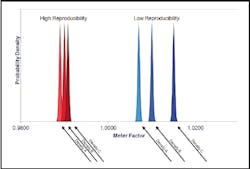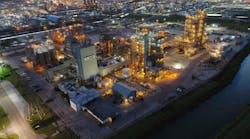DOWNLOAD a PDF of this article as it appeared in Flow Control magazine:
A popular measurement of the quality of a flowmetering system is the ability to repeat the same flow indication at unchanging process conditions (flowrate, fluid properties, temperature and pressure). In the world of metrology, this attribute is termed “repeatability” and a “condition of repeatability” is fairly rigidly defined as a condition, out of a set of conditions, that includes the same measurement, same operator, same measurement system, same operating conditions (process and ambient), same location, and replicate measurements on the same object over a short timeframe.
Figures 1 and 2 graphically show, based on the probability of the density of a measurement repeating, the difference between a low repeatability and high repeatability metering system; the narrower and taller the peak, the more repeatable the instrument.
Closely examining the product specifications of various measurement instruments reveals that the performance specification, often called accuracy, is achieved under specific conditions of repeatability. In real-life, however, it is extremely rare to achieve these specified conditions where an instrument is calibrated and applied utilizing the same operator, same operating conditions, same location, and replicate measurements over a short timeframe. In fact, typically the only location where you can guarantee conditions of repeatability is a calibration laboratory.
An exhaustive investigation into articles, white papers, blogs, textbooks, presentations, and lectures authored by experts in metrology reveals that repeatability is one of the most talked about statistical quality measures of an instrument. When it comes to flowmetering technologies, one of the most repeatable meters available today is a turbine flowmeter. If we examine flowmeters utilized as flow references in gas flow laboratories, the most common are flow nozzles and turbine meters. A flow laboratory is an ideal location for measuring repeatability; and, therefore, highly repeatable flowmeters find their way into a flow laboratory.
Based on the repeatability of turbine meters, it would be reasonable to conclude that a turbine meter is the meter of choice by most metrology experts. This isn’t actually true though, as market studies indicate turbine meters rank approximately sixth among the most popular flowmeter technologies sold, with an optimistic growth rate that is about four times slower than that of the flowmeter technologies that rank No. 1 and No. 2. So, how can it be that a flow technology that so effectively meets one of the most important attributes in metrology isn’t the most popular solution when it comes to use in the marketplace?
Under the Influence
Repeatability performance statistics do not factor in the influence quantities. An influence quantity is an influence that does not affect the quantity that is being measured, but affects the output of the system performing the measurement. Common influences are a change in temperature and pressure (process and ambient), fluid property (density, viscosity), flowrate, or installation conditions (piping, valves, meter orientation). A performance statistic that is an indicator of a measurement system’s immunity to influence quantities is known as “reproducibility.” Reproducibility is the ability of a measurement system, over a set of changing conditions, to replicate the same measurement. A statement of reproducibility should include the conditions changed and unchanged.
Historically, the most common conditions of change included in a reproducibility statement were different locations, operators, and measuring systems. Conditions of change that were rarely included in a reproducibility statement were change in temperature and pressure, fluid property, flowrate, or installation conditions. The reason these conditions of change were rarely included is that traditional flow measurement technologies, typically, do not fare well when these changes are induced. As a result, the calibration of a traditional metering system often involved the development of multiple meter factors to compensate for the metering system’s performance across the range of possible change in conditions.
An illustration of a highly repeatable, traditional flow metering system, and what can happen to its measurement output or meter factor when tested at a higher and lower flowrate than average, is shown in Figure 3.
If the probability density of the metering system’s meter factor is plotted over the range of flowrates shown, the meter factor distribution curve would look similar to Figure 4.
The illustration in Figure 4 shows that, although the metering system is highly repeatable at a single flowrate, when its performance is evaluated over a range of flowrates, its performance is similar to—or worse than—an instrument with low repeatability.
Evolution of Flow Measurement Technology
Measurement systems, and the measurement technologies utilized, have evolved dramatically over the last three decades. Pressure and temperature transmitters historically were very sensitive to ambient temperature changes. Modern versions of these technologies, however, now compensate for ambient temperature changes and in some cases are so accurate that portable field references do not have a low enough uncertainty to properly calibrate these transmitters in the field.
Similarly, the application of traditional flow technologies has evolved. Flow technologies sensitive to viscosity and density changes now have methods to actively correct their performance for these changes. Flow conditioner designs have advanced from a simple tube bundle and upstream pipe lengths to produce more dependable flow profile conditioning for technologies sensitive to this effect.
Some of the most notable advancements in flowmetering technology are attributable to Coriolis and ultrasonic flowmetering technologies. The performance advantages these two technologies have over traditional flowmetering technologies are numerous, but in general, their repeatability is not as good as a turbine or a positive-displacement flowmeter. Although this is true, performance attributes of these newer technologies make their reproducibility under conditions of change far better than their traditional counterparts. An excellent example of this is the Coriolis flowmeter. Its list of beneficial attributes is considerable and includes no wearing parts and high insensitivity to flow profile, density, viscosity, velocity, temperature, and pressure change. In fact, if an evaluation of the technology’s reproducibility based on broad changes in process and fluid property conditions is performed, the technology’s performance far exceeds that of any traditional technology. Similarly, some multipath ultrasonic meters have the ability to actively measure flow velocity profiles (swirl, asymmetries, high and low Reynolds number), and compensate for change in these affects.
Final Analysis
In the analysis and estimation of a measurement system’s repeatability and uncertainty, it can be appropriate and unavoidable to separate the error based on one, or several, of the following factors being held constant:
Equipment
Although this is the case, when possible, it is imperative that the evaluation and selection of a flowmetering technology for a particular application include the influences of real-life conditions. A good example is the influence of viscosity on a flowmeter. A fluid’s viscosity can change with change in temperature; the viscosity of fuel oil in a terminal’s storage compared to that in above-ground piping heated by solar radiation/ambient temperatures can vary significantly. If a metering technology that is susceptible to viscosity change is utilized in an application where these thermal influences exist, a much higher measurement uncertainty can be expected than what the repeatability of the meter under stable thermal conditions would indicate. The selection of a metering technology based on its repeatability alone is the equivalent of buying a car based on its ability to drive in a straight path down a paved road. The users of metering technologies can acquire a great deal of insight into the cause of unacceptable variations in their measurement systems and methods to improve their processes by evaluating the reproducibility of the measurement systems. In most instances, users will be better served asking the question, “How reproducible is my measurement system?” than utilizing repeatability alone as the gatekeeper of low uncertainty measurement.
Karl Stappert is a Flow Solutions Advisor for Emerson’s Flow Solutions Group. He has over 30 years experience with measurement and controls systems in the Oil & Gas industry, including expert-level knowledge in both Coriolis and ultrasonic measurement technologies. Mr. Stappert is a member of the American Gas Association’s Transmission Measurement Committee and the American Petroleum Institute’s Committee on Petroleum Measurement. He can be reached at 918 688-6322 or [email protected].
